Audio Self-supervised Learning: A Survey ( arxiv 2022 )
https://arxiv.org/pdf/2203.01205.pdf
https://www.researchgate.net/publication/358974871_Audio_Self-supervised_Learning_A_Survey/link/6225b0ed84ce8e5b4d0cdbf4/download
Contents
- Abstract
- Audio SSL
- Downstream audio Tasks & Benchmarks
Abstract
1. Self-supervised Learning: A General Overview
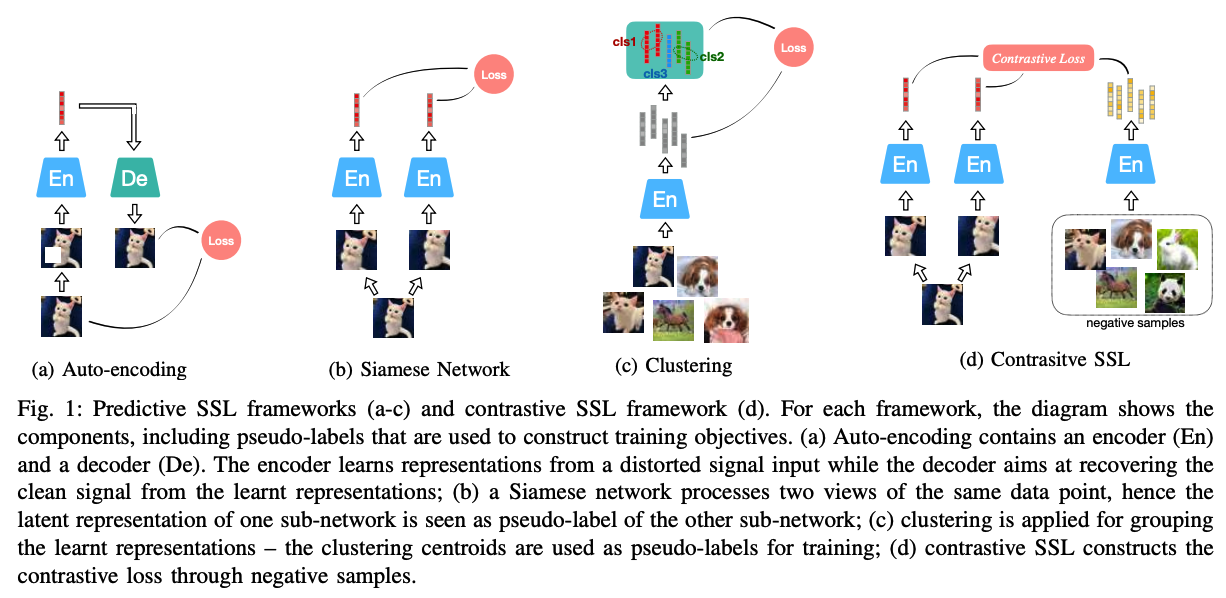
2. Audio SSL
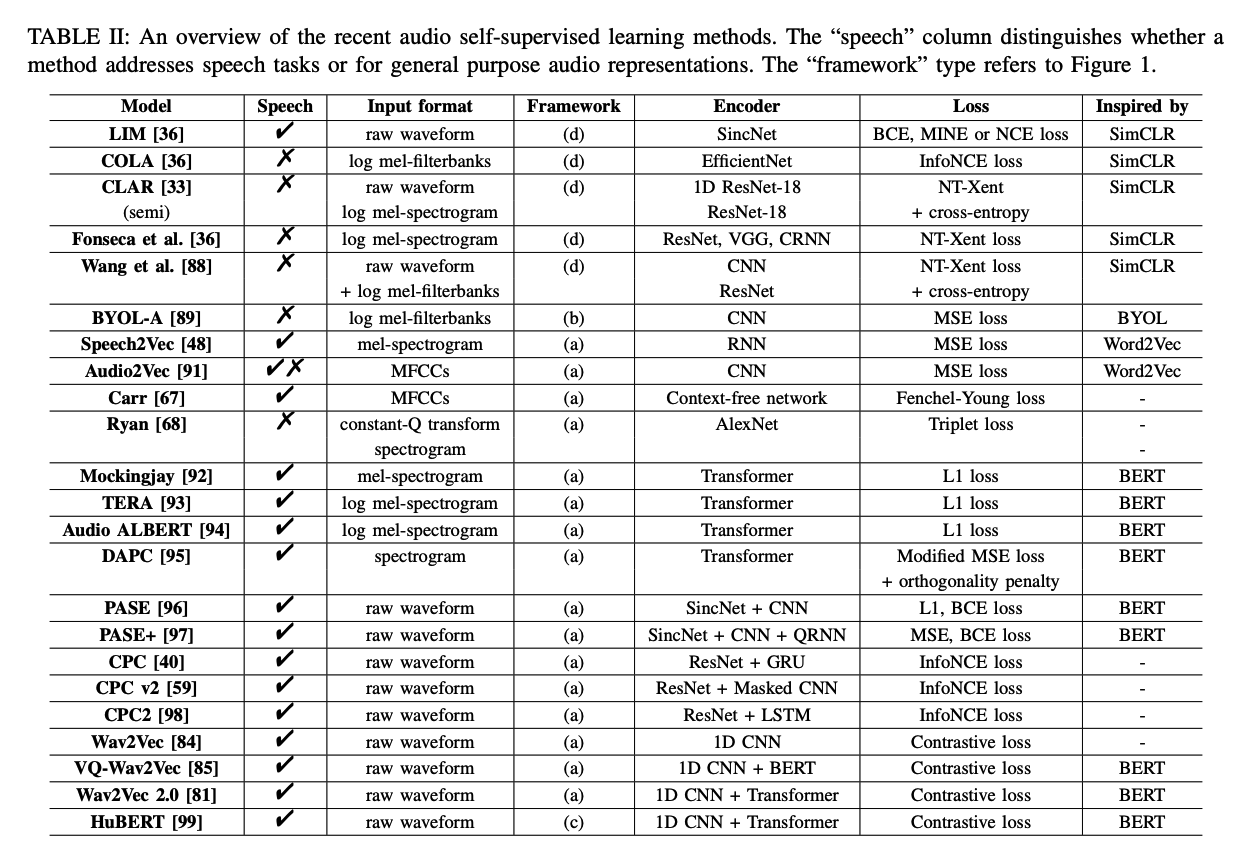
LIM [36], COLA [37], CLAR [33], Fonseca et al. [38]
-
expand the SimCLR approach for learning auditory representations
-
LIM [36]
- processes directly speech samples expecting to maximise “local mutual information” between the encoded representations of chunks of speech sampled from the same utterance
-
COLA [37], Fonseca et al. [38]
-
take segments randomly extracted from time-frequency features along the temporal direction
-
Fonseca et al. [38]
-
several stochastic data augmentations
- ex) random size cropping and Gaussian noise addition
-
proposed “mix-back” for additional augmentation
= which mixes the incoming patch with a background patch, by this ensuring that the incoming patch is dominant in their mixture.
-
-
-
CLAR [33]
-
paired views of the model’s input
= generated by applying data augmentations on raw audio signals and time frequency audio features
-
combining a contrastive loss ( such as CE loss ) for supervised learning can provide significant improvements
-
-
Wang [88]
- also suggests to train audio SSL models with different formats of an audio sample
- training objective = maximise the agreement between the (1) raw waveform and its (2) spectral representation
-
BYOL-A [89]
- adopt BYOL in the audio domain
- learns representations from a single audio without using negative samples
-
Audio2Vec [49], Speech2Vec [48]
-
inspired by Word2Vec [47]
-
learn audio representations using CBoW and skip-gram formulations.
- CBoW : (input, output) = (middle, past&future)
- effective for acoustic scene classification in [90]
- Skip-gram: (input, output) = (past&future, middle)
- CBoW : (input, output) = (middle, past&future)
-
Audio2Vec vs. Speech2Vec
-
(1) Audio Segmentation
-
Speech2Vec : applies audio segmentation, by using an explicit forced alignment technique
-
to isolate audio slices corresponding to each word
( thus, may introduce supervision to some extent )
-
-
Audio2Vec : requires no explicit assistance ( removes the need of supervision )
-
-
(2) Architecture
- Speech2Vec : built based on an RNN encoder-decoder
- Audio2Vec : built of stacks of CNN blocks
-
(3) Input
- Speech2Vec : the Mel-spectrogram
- Audio2Vec : Mel-Frequency Cepstral Coefficients (MFCCs)
-
(4) Temporal Gap ( only Audio2Vec )
-
requests the model to estimate the absolute time distance between two (randomly sampled) slices taken from the same audio clip
( presents the idea of measuring the relative positions of audio components as a pretext task )
-
-
-
-
Carr et al. [67]
- training strategy based on permutations
- ex training a model that can reorder shuffled patches of an audio spectrogram
- also leverage differentiable ranking to integrate permutation inversions into an end-to-end training
- enables solving the permutation inversion for the whole set of permutations
- training strategy based on permutations
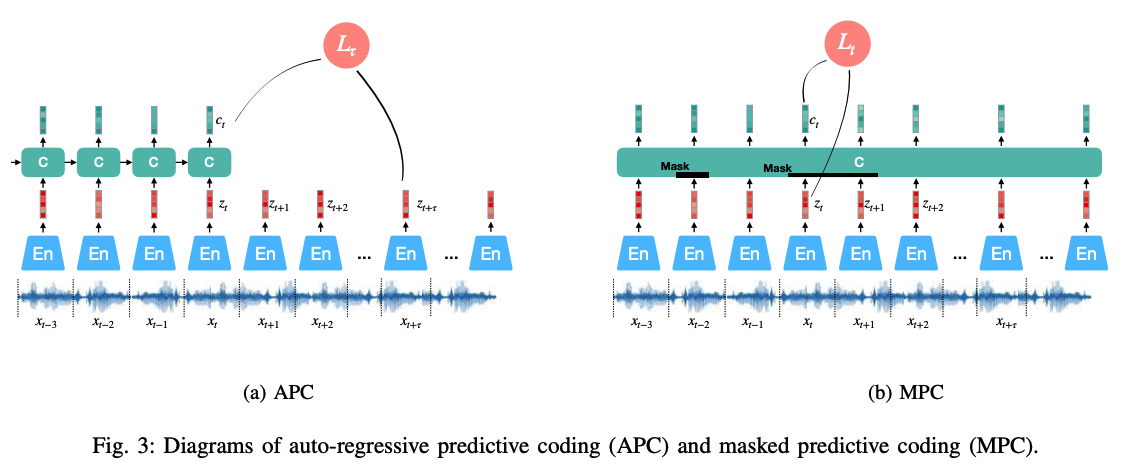
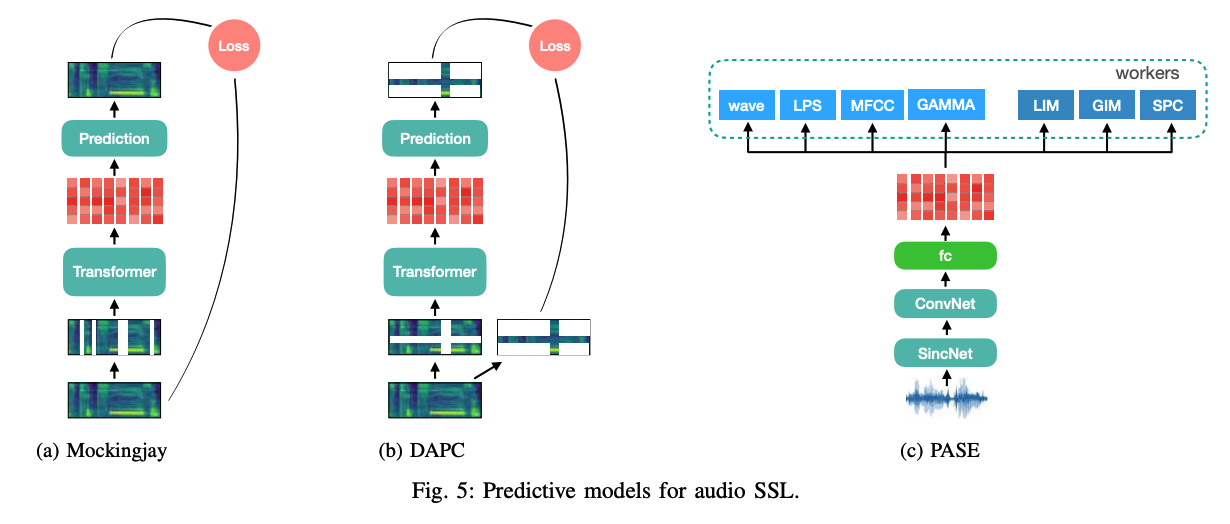
Predictive model using an auto-encoder
( exploits a masked acoustic model (MAM) )
Reconstruct ENTIRELY : [92]–[94]
- Mockingjay [92]
- takes the Mel-spectrogram as input acoustic features
- exploits transformers to code randomly masked frames into audio representations.
-
Audio ALBERT [94]
-
same network architecture as Mockingjay
-
but the parameters are shared across all its transformer encoder layers
$\rightarrow$ achieving a faster inference and increasing training speed
-
- TERA [93]
- TERA = Transformer Encoder Representations from Alteration
- extend the masking procedures
- ex) replacing contiguous segments with randomness
- ex) masking along the channel axis
- ex) applying Gaussian noise
Reconstruct ONLY MASKED : [95]
- DAPC [95]
- only predict the missing components along the timeand frequency axes of an audio spectrogram
- can be seen as extension of CBoW
- input masked spectrogram : generated using SpecAugment [34]
- \(\therefore\) the missing parts to be predicted are not only temporal frames, but also frequency bins.
Various pretrain tasks:
-
PASE [96]
-
PASE = problem agnostic speech encoder
-
combines a CNN encoder with “multiple neural decoders ( =workers )”
( aim at solving regression or binary discrimination tasks )
-
(1) Regression tasks
- recovering the raw audio waveform, the log power sepctrogram, MFCCs, and prosody.
-
(2) Binary discrimination tasks ( contrastive learning )
- by maximising local and global mutual information similar.
$\rightarrow$ Each self-supervised task is expected to provide a different view of the speech signal!
-
architecture: SincNet [103]
- to process the raw waveform as the encoder input
- performs a convolution with a set of parametrised Sinc functions that implement rectangular band-pass filters.
-
-
PASE+ [97]
- Pase+ = PASE + (1) + (2) + (3)
- (1) additional data augmentation techniques
- (2) more effective workers
- CNN encoder is combined with a Quasi-Recurrent Neural Network (QRNN)
- for capturing long-term dependencies in sequential data in a more efficient way
- Pase+ = PASE + (1) + (2) + (3)
CPC [40]
- effectively learn representations by predicting the future in a latent space using an AR model
- promising results for audio, images, text processing, and reinforcement learning.
- architecture for Audio …
- (1) “strided CNN” to encode raw audio to its latent representation.
- (2) “GRU-RNN” to aggregate the information from all the past timesteps to form a context vector.
- Contrastive learning
- contrast the true future to noise representations, given an aggregated context vector.
- Time-domain data augmentation ( such as WavAugment [98] )
- ex) pitch modification, additive noise, reverberation, band reject filtering, or time masking
CPC2 [98]
-
two modifications to CPC
-
(1) GRU-RNN of CPC $\rightarrow$ a two-layers LSTM-RNN
-
(2) linear prediction network $\rightarrow$ a single multi-head transformer layer
-
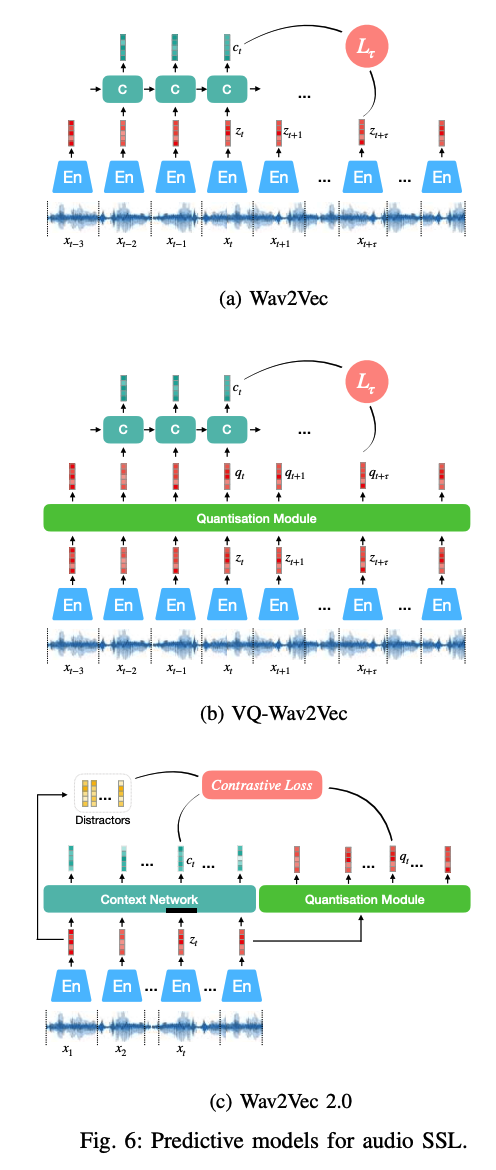
Wav2vec [84]
- adjusts the CPC structure to a fully convolutional architecture
- CNN (1) : used to produce a representation from audio
- CNN (2) : captures global context information into a context vector for each time step
- substantially improves a character-based ASR system
- minimising contrastive loss for each step \(k=1, \ldots, K\) :
- \(L_k=-\sum_{i=1}^{T-k}\left(\operatorname { l o g } \sigma \left(z_{i+k}^T h_k\left(c_i\right)+\lambda \mathbb{E}\left[\log \sigma\left(-\tilde{z}^T h_k\left(c_i\right)\right]\right)\right.\right.\).
- \[\sigma(x)=1 /(1+\exp (-x))\]
- \(\sigma\left(z_{i+k}^T h_k\left(c_i\right)\right.\) : the probability of \(z_{i+k}\) being the true future sample
- \(h_k\left(c_i\right)=W_k c_i+b_k\).
- \(L_k=-\sum_{i=1}^{T-k}\left(\operatorname { l o g } \sigma \left(z_{i+k}^T h_k\left(c_i\right)+\lambda \mathbb{E}\left[\log \sigma\left(-\tilde{z}^T h_k\left(c_i\right)\right]\right)\right.\right.\).
- final loss : \(L=\sum_{k=1}^K L_k\)
VQ-Wav2vec [85]
-
similar to a vector-quantised VAE (VQ-VAE)
\(\rightarrow\) exploit a vector quantisation module after the wav2vec encoder
-
aims to find, for each representation, the closest embedding from a fixed size codebook \(e \in \mathbb{R}^{V \times d}\)
- codebook : contains \(V\) representations of size \(d\).
-
“Discrete representations” are fed into the context network & optimised in the same way as for wav2vec.
-
use Gumbel-Softmax to solve the discontinuity caused by the argmax operation
Mode collapse in single codebook
( Using a single codebook for coding representations tends to mode collapse )
\(\rightarrow\) solution : multiple codebooks are used as in product quantisation!
-
product quantisation = choosing quantised representations from multiple codebooks and concatenating them.
-
Given \(G\) codebooks with \(V\) entries \(e \in \mathbb{R}^{V x d / G}\), one entry from each codebook is selected.
-
A linear transformation is applied after concatenating the selected codewords.
-
probabilities for choosing the \(v\)-th codebook entry for group \(g\) : \(p_{g, v}=\frac{e^{\left(l_{g, v}+n_v\right) / \tau}}{\sum_{k=1}^V e^{\left(l_{g, k}+n_k\right) / \tau}}\).
- where \(l \in \mathbb{R}^{G \times V}\) represent the logits from projecting the encoded dense representation
-
\[n=-\log (-\log (u))\]
- \(u\) are uniform samples from \(U(0,1)\)
\(\rightarrow\) codeword \(i\) in group \(g\) is chosen by \(\operatorname{argmax}_i p_{g, i}\).
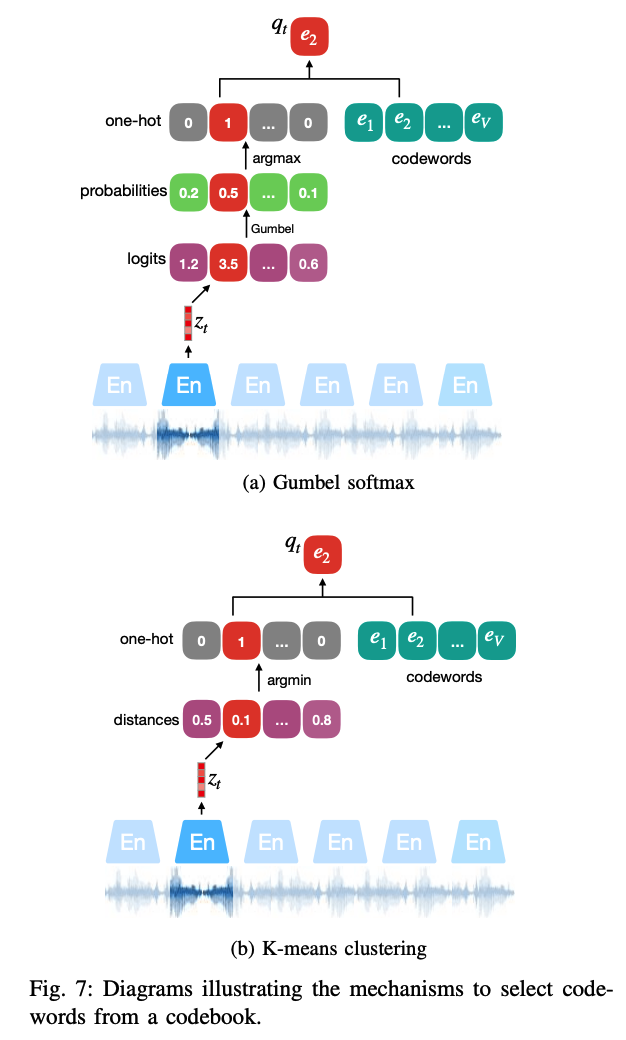
K-means clustering
( = can also be used for differentiable vector quantisation, along with Gumbel Softmax )
- codeword is selected as long as it has the closest distance to the dense representations \(z\).
- additional terms are added in the wav2vec objective function
- \(L=\sum_k L_k+\left( \mid \mid \operatorname{sg}(z)-q \mid \mid ^2+\gamma \mid \mid z-\operatorname{sg}(q) \mid \mid ^2\right)\).
- term \(\mid \mid \operatorname{sg}(z)-q \mid \mid ^2\) = freezes the encoder output \(z\) and forces the codewords \(Q\) to be closer to the encoder output.
- term \(\mid \mid z-\operatorname{sg}(q) \mid \mid ^2\) = drives each encoder output to be close to one codeword, which is one centroid of the K-means clustering.
Wave2vec 2.0
-
Wav2 Vec and VQ-Wav2 Vec : motivated by CPC
- processing audio input for only one forward direction
-
Wav2vec 2.0
- exploits a bidirectional MPC model
-
representations (\(z\)) are partly “MASKED before sending to a transformer network
-
jointly trained to contrast the true representations from distractors, given the contextualised representations.
-
similar to VQ-Wav2Vec, Wav2vec 2.0 applies product quantisation to
-
however, the quantised vector \(q_t\) for each time step in Wave2Vec 2.0 is not fed into a context network, but only used in the objective function:
- \(L=\mathbb{E}\left[-\log \frac{e^{c_t^T q_t / \tau}}{\sum_{\tilde{q} \sim Q_t} e^{c_t^T \tilde{q} / \tau}}\right]\).
- where \(\tilde{q} \sim Q_t\) includes \(q_t\) and \(K\) distractors.
-
Regularised by a diversity loss \(L_d\)
- to encourage the model to use \(V\) codebook entries equally often
- \(L_d=\frac{1}{G V} \sum_{g=1}^G-H\left(\bar{p}_g\right)=\frac{1}{G V} \sum_{g=1}^G \sum_{v=1}^V \bar{p}_{g, v} \log \bar{p}_{g, v}\).
- Wave2vec 2.0 has been explored from the perspective of domain shift in [111]
- Findings (1): matching conditions between data of pre-training and testing are very important in order to achieve satisfying speech recognition results.
- Findings (2): pre-training on multiple domains can improve the generalisation ability of the learnt representations.
Summary: Wav2vec audio SSL models
- learn latent representations without considering specific tasks for pre-training.
- After pre-training, they are fine-tuned for downstream tasks in an additional step.
- Wav2vec-U [116]
- Wav2vec-U = Wav2vec Unsupervised
- learns a map from audio representations to phonemes directly without supervision.
- GAN architecture
- \(G\): generator uses Wav2vec 2.0 to extract speech representations and generate phoneme sequence based on it using a clustering method
- \(D\) : generated phoneme tries to cheat a $D$ that is conditioned on a real phoneme sequence from unlabelled text.
Phonetic clustering in SeqRAAE [87]
-
The idea of grouping quantised audio representations into phoneme sequences
-
discrete representation is learnt in an AE architecture with vector quantisation.
-
consecutive repeated quantised representations are further grouped to form phonetic units
( = Each phoneme can therefore correspond to several repeated codewords, which is similar to the format of Connectionist Temporal Classification (CTC) [117] )
Hidden unit BERT (HuBERT) [99]
-
does not apply CL for training the same MPC model and avoids vector quantisation.
-
each of the learnt audio representation is paired with a pseudo-label provided by applying K-means to MFCCs of the input audio
-
benefits from cluster ensembles
( \(\because\) K-means clustering can be of different numbers of clustering centres = targets of different granularity )
Methods for speech enhancement (SE) task [118], [119]
- share similar structure with the auto-encoding predictive model
- goal: noisy audio input \(\rightarrow\) clean speech.
- noisy = clean speech + mixed with a noise recording
Very recent works in audio SSL
- solve typically challenging tasks, such as
- speech enhancement [120]–[122]
- source separation [123]
- CAE (clean auto-encoder) and MAE (mixture auto-encoder) [120]
- a pair of variational auto-encoders
- CAE : encodes clean speech
- by minimising the reconstruction error of its input spectrogram.
- MAE : encodes a noisy utterance
- forces the encoded representation into the same latent space of the CAE, by using a cycle-consistency loss terms
- learns a mapping from the domain of mixtures to the domain of clean sounds without using paired training examples.
- MixIT [124]
- MixIT = Mixture Invariant Training
- for solving unsupervised sound separation
- Seperation Network
- Input = a mixture of multiple single-channel acoustic mixtures (MOM)
- each of the acoustic mixtures is comprised of several speech sources.
- Goal = decomposes the MOM into separate audio sources
- then selected to be re-mixed up to approximate each acoustic mixture of the MOM.
- ( Similarly as for the Permutation Invariant Training (PIT) [125]) the remix matrix is optimised by choosing the best match between the separated sources and the acoustic mixtures )
- Input = a mixture of multiple single-channel acoustic mixtures (MOM)
- Denoising pretraining [123]
- alternative solution to solve the permutation switching problem of source separation
- pretraining task = speech denoising
- fine-tuned task = source separation
PSE ( SE system specialised in a particular person )
-
two SSL algorithms :
- (1) pseudo speech enhancement (PseudoSE)
- (2) Contrastive mixtures (CM)
for extracting speaker-specific discriminative features.
- (1) PseudoSE model
- trained to recover a premixture signal from a pseudo-source
- premixture signal = clean speech contaminated by noise
- pseudo-source = a mixup of the premixture signal and additional noise
- trained to recover a premixture signal from a pseudo-source
- (2) CM method
- generalises the training via contrastive learning
- positive & negative
- positive : shares the same premixture signal (but deformed with different additional noises),
- negative : stems from two different premixture sources mixed with the same additional noise.
- trained to recover premixture sources rather than clean speech
Data purification (DP) [126]
-
introduced in the pseudo speech enhancement training
-
separate model is trained to estimate the segmental SNR of the premixture signals,
( measuring the different importance of the audio frames )
3. Downstream audio Tasks & Benchmarks
Several different downstream audio tasks have been considered for empirically measuring the audio representation quality!
- (1) Automatic Speech Recognition (ASR)
- used for evaluating all Wav2vec based methods [81], [84], [85].
- (2) Spekaer Identification [36], [45], [103]
- (3) Speech emotion recognition [32], [157]-[159]
- (4) Speech machine translation [160]
- (5) pitch detection [161]
- (6) acoustic scene classification [90]
Will describe some publicly available benchmarks that enable a fair comparisons between different audio SSL algorithms.
(1) Zero resource Speech challenge (ZeroSpeech) [162]
a) Challenge in 2015
-
task of unsupervised discovery of linguistic units from raw speech in an unknown language
-
tasks are split into two tracks
- (1) unsupervised sub-word modelling
- (2) spoken term discovery
\(\rightarrow\) each focusing on a different level of linguistic structure.
(1) unsupervised sub-word modelling
- aims at constructing a representation of speech sounds that is robust to within- and between-speaker variation and supports word identification
(2) spoken term discovery
- aims at unsupervised discovery of ‘words’, taking raw speech as input.
b) Challenge in 2017
extend the study for the variants in language and speaker
- considering the topic of cross-language generalisation and speaker adaptation
c) Challenge in 2017
to address the problem of a speech synthesiser without any text or phonetic labels.
goal: discover sub-word units in an unsupervised way given raw audio.
d) Challenge in 2021
several tasks for spoken language modelling, based on speech only as well as visually-grounded.
(2) Speech processing Universal PERformance Benchmark (SuperB)
Present a standard and comprehensive testbed for evaluation which can be generally applied to pre-trained models on various tasks.
10 downstream tasks are provided
- Phoneme Recognition, Automatic Speech Recognition, Keyword Spotting, Query by Example Spoken Term Detection, Speaker Identification, Automatic Speaker Verification, Speaker Diarisation, Intent Classification, Slot Filling, and Emotion Recognition.
(3) LeBenchmark [164]
another reproducible and multifaceted benchmark for evaluating speech SSL models for the French language.
4 tasks
- Speech Recognition (ASR), Spoken Language Understanding (SLU), Speech Translation (AST), and Emotion Recognition (AER).
(4) Libri-Light [165]
benchmark specifically designed for the task of ASR with limited or no supervision
- based on spoken English audio collected from open-source audio books of the LibriVox project.
(5) HEAR
HEAR = Holistic Evaluation of Audio Representations
- extends a benchmark suite for both speech and non-speech tasks
- goal : create an audio representation that is as holistic as the human ear
3 main tasks in HEAR 2021
- word classification, pitch detection, and sound event detection
